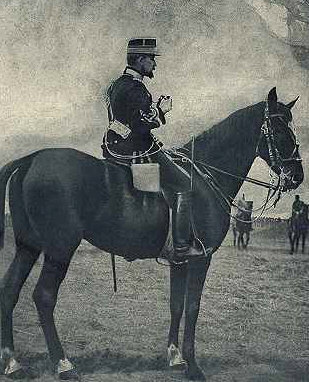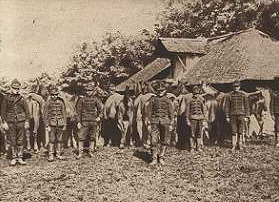The Fall of Bucharest
December 5, 1916

Ferdinand, King of Rumania During the War
On December 5, 1916, the Romanian capital of Bucharest fell to enemy forces and effectively brought an end to Romania's disastrous participation in the First World War. Romania remained neutral in the early stages of the war, only to find itself assailed by German, Bulgarian, Austro-Hungarian, and Ottoman forces by the end of 1916. The main Romanian national interest was in Hapsburg controlled Transylvania, home to three million Romanians. Allied success would begin the process that led to the decimation of the Romanian army. The success of the Brusilov offensive made Romania more inclined to accept Allied territorial offerings in return for participation. On August 17, 1916, France and Russia agreed to reward Romania with Transylvania, the Bukovina, the southern tract of Galicia, and the Barat after the peace treaty in return for their participation on the Allied side (Keegan, 2000). The strategic situation for Romania was precarious and they were surrounded by enemy forces on three sides, nonetheless they entered the war on August 27, 1916.
Bolstered by their performance in the Second Balkan war and confident of the Russian army checking the German and Austro-Hungarian forces, the Romanians overestimated the potential of their twenty three division army. The Romanian army paid scant attention to the threat of Bulgarian or Ottoman attacks. Russian Commander in Chief Alexeyev believed Romanian participation to be more of a hindrance than asset, he would be proven correct. While Allied forces attempted a diversionary attack at Salonika, the Romanian army invaded the Austro-Hungarian Empire through the passes of the Transylvanian Alps and occupied Eastern Transylvania (Keegan, 2000). Allied commanders had expected the Romanians to attack Bulgaria. This would be the highpoint of Romanian participation in the war. While Romanian forces did nothing after their initial success, German, Austro-Hungarian, and Bulgarian forces prepared a counter attack Austro-Hungarian local defense forces were quickly organized into the First Army to oppose the Romanians and on September 2nd, Bulgarian forces invaded the Romanian province of the Dobruja. On September 25th, German forces under Falkenhayan began to drive the Romanians back through the Transylvanian passes. Part of this German force was composed of the Alpenkorps and included the young Erwin Rommel. After driving the Romanian army through the Transylvanian passes, German forces continued to force the Romanians toward the central plains of Romania and toward Bucharest. By late 1916, German and Austro-Hungarian forces were assailing the Romanian army and driving them further into their own borders while Bulgarian and Ottoman forces were in the Dobruja province, the Ottomans having taken the sea route to assist in the assault. On December 5, 1916, Mackensen's German forces crossed the Danube and took Bucharest, the Romanians retreated to Moldavia and entrenched themselves between the Sereth River and Russian border.

Rumanian Cavalry in the Field
The Romanian decision to enter the war was disastrous. By the end of 1916, they had lost 310,000 men, nearly half as prisoners, and almost the whole of their country (Keegan, 1916). Their defeat also left Germany in control of the Ploesti oilfields, the only source of European oil west of the Black Sea. Germany gained one million tons of oil and two million tons of grain through their defeat of Romanian and these gains would help continue the German war effort into 1918. Not only did their victory yield material gains, but the German victory also necessitated the diversion of Russian forces to rescue the Romanian army. The results of the Allied recruitment of Romania did not prove a benefit to the Allied cause, but actually diminished allied strength and forced a diversion of resources. Romania's decision became their folly.
By Matt Church
University of Louisville
Works Cited
Keegan, John. The First World War. New York: Viking Press, 1995.
Click "Back" Icon to Return to Page.
|
